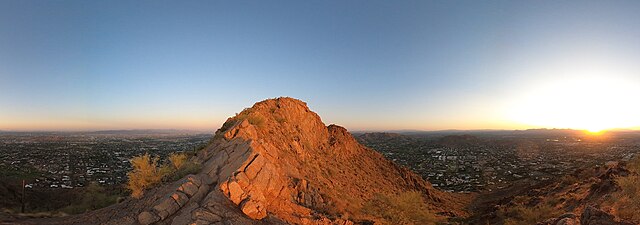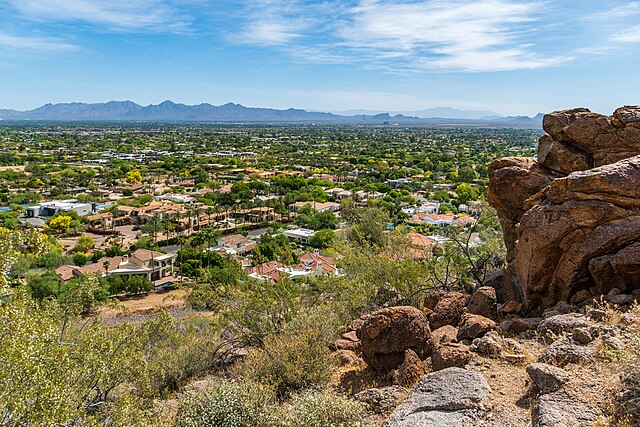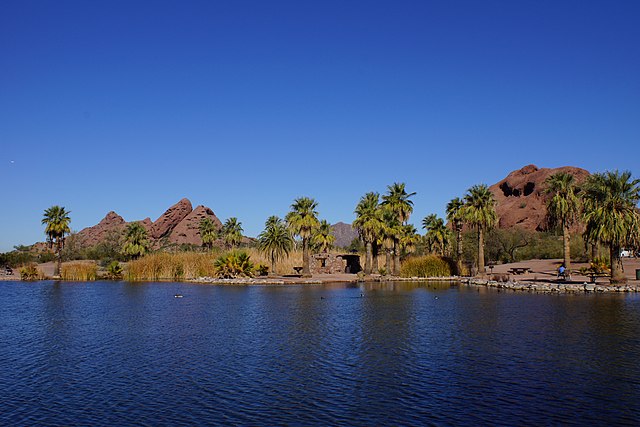Imagine standing atop a majestic red sandstone peak, the sprawling Phoenix valley stretching endlessly below you, painted in hues of gold and amber as the desert sun bathes everything in its warm glow. This isn’t just a dream—it’s the reality that awaits you on Camelback Mountain, one of Arizona’s most iconic natural landmarks and a paradise for outdoor enthusiasts.
Have you ever wondered what makes certain places stick in your memory forever? Camelback Mountain is one of those magical destinations that leaves an indelible mark on every visitor’s soul. Whether you’re a seasoned hiker looking for your next challenge or a photography enthusiast seeking that perfect shot, this desert giant offers adventures that will transform your perspective on Arizona’s natural beauty.
What Makes Camelback Mountain Special?
Camelback Mountain isn’t just another hiking destination—it’s a living testament to millions of years of geological history and a playground for adventure seekers from around the world. This distinctive peak has earned its place as one of Phoenix’s most beloved natural attractions, drawing over 300,000 visitors annually who come to experience its unique blend of challenging terrain and breathtaking scenery.
Geographic Location and Significance
Nestled in the heart of the Valley of the Sun, Camelback Mountain rises 2,704 feet above sea level, making it the highest point in Phoenix. The mountain spans approximately 1.5 miles long and earned its name from its distinctive silhouette, which resembles a kneeling camel when viewed from the north or south. This geological marvel sits at the intersection of Phoenix and Scottsdale, making it easily accessible from both cities.
The mountain’s strategic location places it at the center of the Sonoran Desert ecosystem, where you’ll encounter a diverse array of desert plants and wildlife. It’s not just a mountain—it’s a living laboratory where visitors can observe how life thrives in one of North America’s most challenging environments.
Unique Rock Formations and Geology
What sets Camelback Mountain apart from other desert peaks is its fascinating geological composition. The mountain consists primarily of red sandstone and granite, creating a striking contrast against the desert landscape. These rock formations tell a story that spans millions of years, with layers of sedimentary rock revealing ancient sea beds and volcanic activity.
The distinctive red coloration comes from iron oxide deposits within the sandstone, creating those Instagram-worthy shots that make your friends back home jealous. As you climb, you’ll notice how the rock face changes, offering different textures and colors that make each section of your adventure unique.
Top Hiking Trails on Camelback Mountain

When it comes to conquering Camelback Mountain, you have two main trail options, each offering its own personality and challenges. Think of these trails as two different paths to the same incredible destination—one bold and direct, the other more subtle and contemplative.
Echo Canyon Trail: The Classic Challenge
The Echo Canyon Trail is Camelback Mountain’s most famous route, and for good reason. This 1.14-mile trail to the summit is like the mountain’s calling card—steep, challenging, and absolutely rewarding. Don’t let the short distance fool you; this trail packs more punch per mile than most hikers expect.
Trail Difficulty and What to Expect
Echo Canyon isn’t for the faint of heart. The trail gains over 1,200 feet in elevation, making it a legitimate workout that will test your endurance and determination. You’ll encounter sections where you’ll need to use your hands to navigate steep rock faces, making it feel more like rock scrambling than traditional hiking.
The trail features metal handrails at the most challenging sections, installed to help hikers navigate the steepest parts safely. These aren’t just suggestions—they’re lifelines that have helped countless adventurers reach the summit. The final push to the top requires careful footing and a good head for heights, but the panoramic views waiting at the summit make every challenging step worthwhile.
Best Times to Hike Echo Canyon
Timing your Echo Canyon adventure is crucial for both safety and enjoyment. The golden hours—early morning and late afternoon—offer the best hiking conditions. Starting your hike before 6 AM during summer months isn’t just recommended; it’s essential for avoiding dangerous heat exposure.
Winter months (November through March) provide the most comfortable hiking conditions, with daytime temperatures ranging from 65-75°F. Spring and fall offer moderate temperatures, while summer hiking requires extreme caution and should only be attempted by experienced desert hikers during pre-dawn hours.
Cholla Trail: The Hidden Gem
If Echo Canyon is the mountain’s extroverted personality, then Cholla Trail is its more introspective side. This 1.42-mile trail offers a different perspective on the mountain, both literally and figuratively, providing a slightly less crowded but equally rewarding experience.
Why Cholla Trail is Less Crowded
Cholla Trail’s relative obscurity works in your favor if you prefer a more peaceful hiking experience. The trailhead is less obvious and requires a bit more navigation to find, which naturally filters out some of the casual hikers. This means you’ll have more opportunities to connect with nature and enjoy the mountain’s serene beauty without fighting for photo spots.
The trail approaches the summit from the east side, offering different geological formations and plant life than its more famous cousin. You’ll encounter more technical rock scrambling near the summit, making it feel like a more authentic wilderness experience.
Flora and Fauna Along the Way
As you ascend Cholla Trail, you’ll become intimately acquainted with the Sonoran Desert’s incredible biodiversity. The trail’s namesake—cholla cacti—line the path with their distinctive fuzzy appearance that belies their sharp, unforgiving spines. You’ll also encounter saguaro cacti, palo verde trees, and during spring months, a spectacular display of desert wildflowers.
Keep your eyes peeled for desert wildlife, including roadrunners, javelinas, and various lizard species. Early morning hikers often spot coyotes and desert foxes, while bird enthusiasts can observe hawks, owls, and numerous desert songbirds throughout the day.
Adventure Activities Beyond Hiking

While hiking dominates most visitors’ Camelback Mountain experience, the adventure possibilities extend far beyond just putting one foot in front of the other. This desert playground offers opportunities for thrill-seekers and creative souls alike.
Rock Climbing Opportunities
Camelback Mountain’s unique rock formations create natural climbing routes that challenge both beginners and advanced climbers. The mountain’s red sandstone and granite faces offer various difficulty levels, from easy scrambles to technical multi-pitch routes that require advanced skills and equipment.
Local climbing guides recommend the north face for beginners, where the rock is more solid and routes are well-established. Advanced climbers gravitate toward the steeper south-facing routes, which offer more technical challenges and require specialized desert climbing techniques.
Photography Adventures
If you’re passionate about photography, Camelback Mountain transforms into an outdoor studio with unlimited creative possibilities. The mountain’s dramatic landscapes, diverse textures, and ever-changing light conditions provide endless subjects for both amateur and professional photographers.
Sunrise and Sunset Photography Tips
The magic hours at Camelback Mountain are truly magical. Sunrise photography from the summit captures the valley awakening below, with the city lights gradually giving way to golden desert light. Position yourself on the east side of the summit for the best sunrise compositions, where you can capture the sun emerging over the distant mountains.
Sunset photography offers equally stunning opportunities, with the mountain’s red rocks glowing like embers against the darkening sky. The west-facing slopes provide perfect foreground elements for sunset shots, while the summit offers panoramic views of the valley bathed in golden light.
Essential Preparation for Your Camelback Mountain Adventure
Success on Camelback Mountain starts long before you set foot on the trail. Proper preparation isn’t just about having a good time—it’s about staying safe and making the most of your desert adventure.
What to Bring: Gear and Supplies
Your Camelback Mountain gear list should prioritize hydration, sun protection, and safety. Water is your most critical supply—plan for at least one liter per person, and double that during summer months. Electrolyte replacement drinks help maintain proper hydration balance in the desert heat.
Sun protection gear is non-negotiable. Wide-brimmed hats, high-SPF sunscreen, and UV-protective clothing shield you from intense desert sun that can cause burns even on cloudy days. Sturdy hiking boots with good ankle support are essential for navigating the rocky terrain safely.
Emergency supplies should include a first aid kit, whistle, and cell phone with emergency contacts programmed. Consider bringing trekking poles for additional stability during steep sections, and don’t forget snacks to maintain energy levels throughout your adventure.
Physical Fitness Requirements
Camelback Mountain demands respect for its challenging terrain. While you don’t need to be an elite athlete, a basic level of cardiovascular fitness and leg strength will make your experience much more enjoyable and safer.
Training Tips for Beginners
If you’re new to desert hiking, start preparing at least 4-6 weeks before your Camelback Mountain adventure. Focus on building cardiovascular endurance through activities like stair climbing, walking on inclines, and hiking shorter trails in your area.
Leg strength training is crucial for handling the steep terrain. Squats, lunges, and calf raises help build the muscle groups you’ll rely on during your climb. Don’t neglect your core strength, which plays a vital role in maintaining balance on uneven surfaces.
Safety Considerations and Guidelines
Desert hiking presents unique challenges that require specific safety awareness and preparation. Understanding these risks and how to mitigate them can mean the difference between an amazing adventure and a dangerous situation.
Weather Awareness in the Sonoran Desert
The Sonoran Desert’s weather can change rapidly and dramatically impact your hiking experience. Summer temperatures regularly exceed 110°F, creating life-threatening conditions for unprepared hikers. Heat exhaustion and heat stroke are real dangers that affect dozens of hikers annually.
Winter weather brings its own challenges, including occasional freezing temperatures at higher elevations and sudden storms that can make rock surfaces slippery and dangerous. Always check current weather conditions and forecasts before heading out, and be prepared to turn back if conditions deteriorate.
Wildlife Encounters and Precautions
Camelback Mountain’s wildlife is generally more afraid of you than you are of them, but encounters do occur. Rattlesnakes are present throughout the mountain and are most active during warmer months. Stay on designated trails, watch where you step, and never reach into areas you can’t see clearly.
Javelinas (wild pigs) occasionally cross paths with hikers, especially during early morning and evening hours. These animals are generally harmless but can become aggressive if they feel threatened or if they’re protecting young. Give them plenty of space and never attempt to feed them.
Best Times to Visit Camelback Mountain

Timing your Camelback Mountain adventure properly can make the difference between an incredible experience and a miserable ordeal. The desert’s extreme conditions demand careful planning and respect for seasonal variations.
Seasonal Considerations
Winter months (December through February) offer the most comfortable hiking conditions, with daytime temperatures ranging from 60-70°F and cool, crisp mornings perfect for early starts. This is peak season, so expect larger crowds and busier parking areas.
Spring (March through May) brings mild temperatures and spectacular wildflower displays following winter rains. Desert lupine, poppies, and brittlebush create colorful carpets across the landscape, making this season ideal for photography enthusiasts.
Summer hiking (June through August) requires extreme caution and should only be attempted by experienced desert hikers during pre-dawn hours. Many trails close to hikers after 11 AM due to dangerous heat conditions.
Avoiding Crowds: Timing Your Visit
Early morning starts aren’t just safer—they’re also your best strategy for avoiding crowds. Begin your hike before 6 AM to enjoy the mountain’s peaceful morning atmosphere and secure parking at the trailhead. Weekdays are significantly less crowded than weekends, especially during peak season.
Late afternoon hikes can be rewarding during cooler months, offering opportunities for sunset photography and evening wildlife viewing. However, always carry headlamps and plan your descent carefully, as desert darkness falls quickly.
Nearby Attractions and Extended Adventures
Your Camelback Mountain adventure doesn’t have to end at the summit. The surrounding area offers numerous attractions and activities that complement your desert hiking experience.
Papago Park and Hole-in-the-Rock
Just a short drive from Camelback Mountain, Papago Park offers easier hiking options and unique geological formations. The famous Hole-in-the-Rock trail is perfect for families or those seeking a less strenuous adventure while still experiencing Arizona’s desert beauty.
The park also houses the Desert Botanical Garden, where you can learn about Sonoran Desert plants and their adaptations. This educational experience helps you better appreciate the flora you encountered on Camelback Mountain.
Piestewa Peak Alternative
If you’re looking for another challenging hike, Piestewa Peak (formerly Squaw Peak) offers a similar desert mountain experience with its own unique character. At 2,610 feet, it’s slightly lower than Camelback Mountain but provides equally stunning views and challenging terrain.
The 2.4-mile round trip summit trail attracts serious hikers and trail runners, offering a different perspective on the Phoenix valley and surrounding desert landscape.
Local Tips from Phoenix Adventurers
Phoenix locals have developed insider knowledge about Camelback Mountain that can enhance your adventure. Experienced hikers recommend starting your climb before sunrise to witness the spectacular dawn light painting the desert landscape in brilliant colors.
Parking fills up quickly, especially during peak season and weekends. Arrive early or consider using ride-sharing services to avoid parking frustrations. Local hikers often use the “buddy system,” hiking with partners for safety and companionship.
Many Phoenix adventurers recommend combining your Camelback Mountain hike with visits to nearby attractions like the Musical Instrument Museum or Old Town Scottsdale, creating a full day of Arizona experiences.
Conclusion
Camelback Mountain stands as more than just a hiking destination—it’s a gateway to understanding Arizona’s incredible natural beauty and your own capabilities as an adventurer. From the challenging scrambles of Echo Canyon to the peaceful solitude of Cholla Trail, this desert giant offers experiences that will stay with you long after you’ve returned home.
The mountain teaches us that the best adventures often require effort, preparation, and respect for the environment. Whether you’re seeking physical challenges, photographic inspiration, or simply a deeper connection with nature, Camelback Mountain delivers experiences that transform casual visitors into passionate desert advocates.
Remember that every step on this mountain is a privilege, and with that privilege comes responsibility. Follow Leave No Trace principles, respect wildlife, and help preserve this natural treasure for future generations of adventurers.
Your Camelback Mountain adventure awaits. Are you ready to answer the call of the desert?
Frequently Asked Questions
Q: How long does it take to hike to the summit of Camelback Mountain?
A: Most hikers take 1.5-3 hours to reach the summit and return, depending on their fitness level and chosen trail. Echo Canyon typically takes 2-2.5 hours round trip, while Cholla Trail may take 2.5-3 hours for most hikers.
Q: Is Camelback Mountain suitable for beginners?
A: While Camelback Mountain is challenging, determined beginners can successfully complete the hike with proper preparation. Start training 4-6 weeks in advance, bring plenty of water, and consider hiking during cooler months for your first attempt.
Q: What’s the best time of year to hike Camelback Mountain?
A: November through March offers the most comfortable hiking conditions, with moderate temperatures and clear skies. Spring (March-May) provides beautiful wildflower displays, while summer hiking should only be attempted by experienced desert hikers during pre-dawn hours.
Q: Are there facilities like restrooms and water fountains at the trailheads?
A: Both Echo Canyon and Cholla trailheads have restroom facilities, but there are no water fountains or water sources on the mountain. You must bring all the water you’ll need for your hike—plan for at least one liter per person.
Q: Can I bring my dog on Camelback Mountain?
A: Dogs are allowed on Camelback Mountain but must be leashed at all times. However, the rocky terrain and extreme heat make this hike challenging for pets. Consider your dog’s fitness level and paw protection, and avoid summer months entirely for pet safety.

